In Cecil B. De Mille's lavish historical epic The Sign of the Cross (1932), a Roman soldier becomes torn between his love for a Christian woman and his loyalty to Emperor Nero. The outstanding cast is one of the film's strongest points. Fredric March is stalwart as the Roman official who falls in love with a sweet Christian girl, played by Elissa Landi. But they are upstaged by the villains, Charles Laughton and Claudette Colbert playing Emperor Nero and his wife Empress Empress Poppaea. The Sign of the Cross (1932) is the third and last in DeMille's biblical trilogy with The Ten Commandments (1923) and The King of Kings (1927).
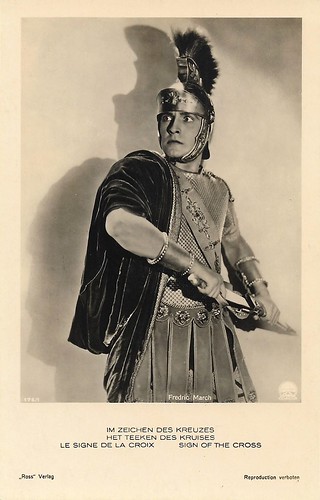
German postcard by Ross Verlag, no. 176/1. Photo: Paramount. Fredric March in The Sign of the Cross (Cecil B. deMille, 1932).
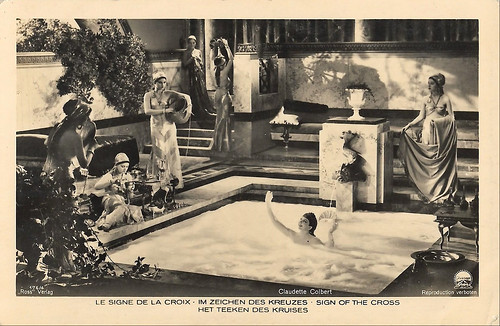
Dutch-German postcard by Ross Verlag, no. 176/4. Photo: Paramount. Claudette Colbert in Sign of the Cross (Cecil B. DeMille, 1932). On the back: Boekhandel Leonard Tijssen, Leeuwarden.
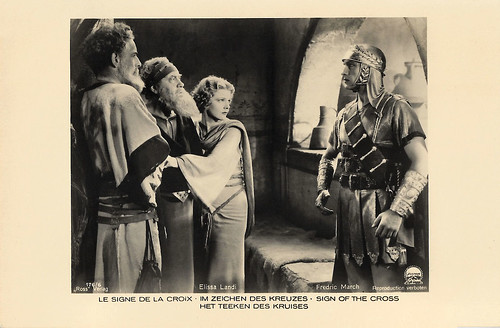
German postcard by Ross Verlag, no. 176/6. Photo: Paramount. Elissa Landi and Fredric March in The Sign of the Cross (Cecil B. DeMille, 1932).
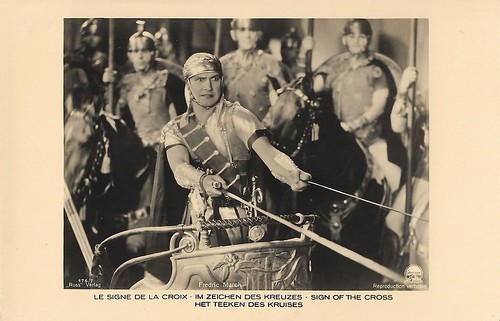
German postcard by Ross Verlag, no. 176/7. Photo: Paramount. Fredric March in The Sign of the Cross (Cecil B. DeMille, 1932). The title is indicated in French, German English and Dutch.
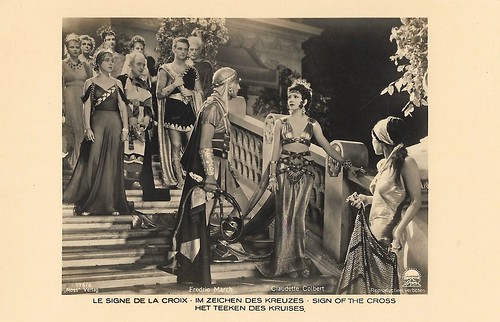
German postcard by Ross Verlag, no. 176/8. Photo: Paramount. Fredrich March and Claudette Colbert in The Sign of the Cross (Cecil B. DeMille, 1932).
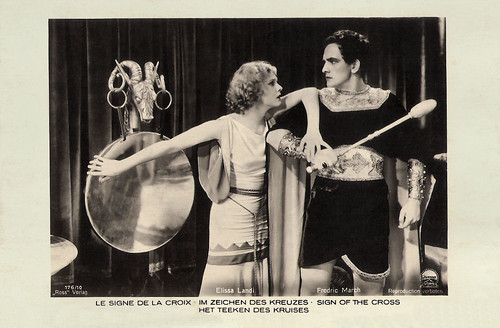
German postcard by Ross Verlag, no. 176/10. Photo: Paramount. Elissa Landi and Fredric March in The Sign of the Cross (Cecil B. DeMille, 1932).
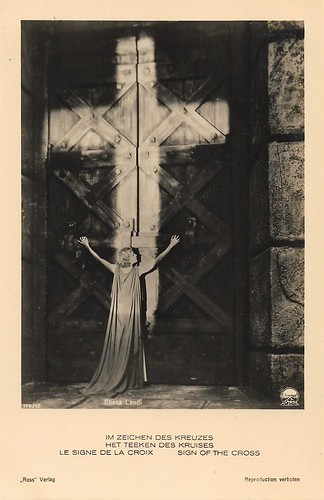
German postcard by Ross Verlag, no. 176/12. Photo: Paramount. Elissa Landi in The Sign of the Cross (Cecil B. DeMille, 1932), based on the original 1895 play by Wilson Barrett.
In 1932 – at the height of the depression, Paramount was in financial straits and Hollywood's output was mostly limited to small-scale dramas and bedroom comedies. However, Cecil B. DeMille decided to make an epic. Against all odds, he carryied the torch for grandeur and spectacle and produced and directed one of his best films, The Sign of the Cross (1931), a vivid retelling of the struggles of the first Christians.
The Roman Empire - First Century A. D. After burning Rome, Emperor Nero Claudius Caesar (Charles Laughton) decides to blame the Christians, and issues the edict that they are all to be caught and sent to the arena. The mad Emperor and his his vile Empress engage in every sort of vice and degradation. Wanton cruelty becomes a spectator sport and virtue and innocence are denigrated. Two old Christians are caught, and about to be hauled off, when Prefect Marcus Superbus (Fredric March), the highest military official in Rome, comes upon them. When he sees their stepdaughter Mercia (Elissa Landi), he instantly falls in love with her and frees them.
Marcus pursues Mercia, which gets him into trouble with the Emperor for being easy on the Christians and with Empress Poppaea (Claudette Colbert), who loves him and is jealous. When Landi's Mercia's friends are marched off to the arena to die, she wants to join them. Marcus sacrifices his career by demanding that the emperor spares her life. Nero agrees, but only if she renounces her faith... So, which will eventually triumph - the might of Imperial Rome, or the gentle ones who follow The sign of the cross?
Steffi-P at IMDb: "The acting in Sign of the Cross is a bit of a mixed bag, although it is of a higher standard than many of the DeMille talkies. Charles Laughton is hammily brilliant, laying down a blueprint for Emperor Nero which Peter Ustinov would follow to a well-deserved Oscar-nomination in Quo Vadis (1951). However Laughton's part is fairly small, and the screenplay makes Claudette Colbert the real villain. Colbert is fantastic, playing the Empress as an ancient world vamp, giving by far the best performance of the bunch. It's almost a shame that It Happened One Night re-invented her as a major romantic lead, because she really was at her best when she played villains."
Martin Kukuczka at IMDb adds: "Except for the cruel arena sequence, which is still entertaining in some way, any viewer will be surprised at one scene: Poppaea's famous milk bath. That's a moment that everyone should consider while watching the film. Her sexual bath is one of the best made moments that cinema has ever seen. It is totally filled with desire and sexuality. And all thanks to the great performance by Ms Colbert. No surprise Cecil B DeMille cast her to play Cleopatra two years later, in 1934."
As with many other pre-Code films that were reissued after the Motion Picture Production Code was strictly enforced in 1934, The Sign of the Cross (1932) has a history of censorship. In the original version, Marcus is unsuccessful in his desire to seduce Mercia. He then urges Ancaria (Joyzelle Joyner) to perform the erotic 'Dance of the Naked Moon' that will "warm her into life". This 'lesbian dance' was cut from the negative for a 1938 reissue, but was restored by MCA/Universal for its 1993 video release. Some gladiatorial combat footage was also cut for the 1938 reissue, as were arena sequences involving naked women being attacked by crocodiles and a gorilla. These were also restored in 1993.

British postcard in the series Film Shots by Film Weekly. Photo: Paramount. Charles Laughton and Claudette Colbert in The Sign of the Cross (Cecil B. DeMille, 1932).

British postcard in the series Film Shots by Film Weekly. Photo: Paramount. publicity still for The Sign of the Cross (Cecil B. DeMille, 1932).
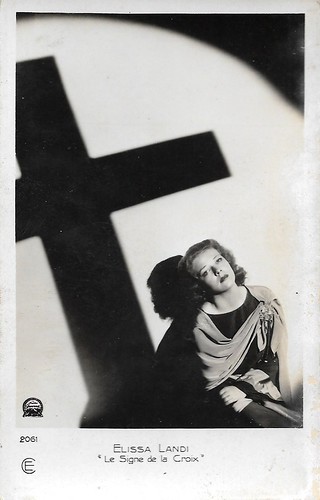
French postcard by Cinémagazine-Edition, no. 2061. Photo: Elissa Landi in The Sign of the Cross (Cecil B. DeMille, 1932).
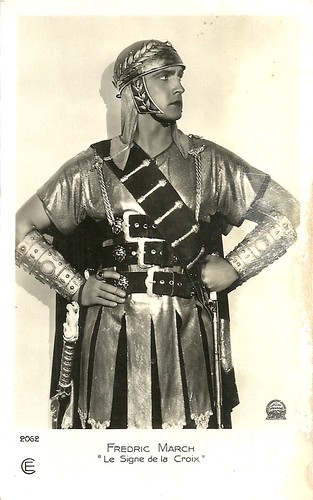
French postcard by Editions Cinémagazine, no. 2062. Photo: Paramount. Fredric March in The Sign of the Cross (Cecil B. DeMille, 1932).
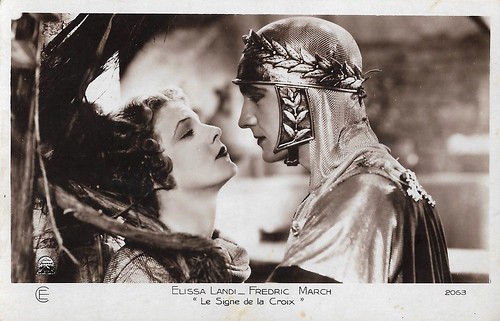
French postcard by Editions Cinémagazine, no. 2063. Photo: Paramount. Fredric March and Elissa Landi in The Sign of the Cross (Cecil B. DeMille, 1932).
Sources: Steffi-P (IMDb), Martin Kukuczka (IMDb), Wikipedia and IMDb.

German postcard by Ross Verlag, no. 176/1. Photo: Paramount. Fredric March in The Sign of the Cross (Cecil B. deMille, 1932).

Dutch-German postcard by Ross Verlag, no. 176/4. Photo: Paramount. Claudette Colbert in Sign of the Cross (Cecil B. DeMille, 1932). On the back: Boekhandel Leonard Tijssen, Leeuwarden.

German postcard by Ross Verlag, no. 176/6. Photo: Paramount. Elissa Landi and Fredric March in The Sign of the Cross (Cecil B. DeMille, 1932).

German postcard by Ross Verlag, no. 176/7. Photo: Paramount. Fredric March in The Sign of the Cross (Cecil B. DeMille, 1932). The title is indicated in French, German English and Dutch.

German postcard by Ross Verlag, no. 176/8. Photo: Paramount. Fredrich March and Claudette Colbert in The Sign of the Cross (Cecil B. DeMille, 1932).

German postcard by Ross Verlag, no. 176/10. Photo: Paramount. Elissa Landi and Fredric March in The Sign of the Cross (Cecil B. DeMille, 1932).

German postcard by Ross Verlag, no. 176/12. Photo: Paramount. Elissa Landi in The Sign of the Cross (Cecil B. DeMille, 1932), based on the original 1895 play by Wilson Barrett.
A famous milk bath
In 1932 – at the height of the depression, Paramount was in financial straits and Hollywood's output was mostly limited to small-scale dramas and bedroom comedies. However, Cecil B. DeMille decided to make an epic. Against all odds, he carryied the torch for grandeur and spectacle and produced and directed one of his best films, The Sign of the Cross (1931), a vivid retelling of the struggles of the first Christians.
The Roman Empire - First Century A. D. After burning Rome, Emperor Nero Claudius Caesar (Charles Laughton) decides to blame the Christians, and issues the edict that they are all to be caught and sent to the arena. The mad Emperor and his his vile Empress engage in every sort of vice and degradation. Wanton cruelty becomes a spectator sport and virtue and innocence are denigrated. Two old Christians are caught, and about to be hauled off, when Prefect Marcus Superbus (Fredric March), the highest military official in Rome, comes upon them. When he sees their stepdaughter Mercia (Elissa Landi), he instantly falls in love with her and frees them.
Marcus pursues Mercia, which gets him into trouble with the Emperor for being easy on the Christians and with Empress Poppaea (Claudette Colbert), who loves him and is jealous. When Landi's Mercia's friends are marched off to the arena to die, she wants to join them. Marcus sacrifices his career by demanding that the emperor spares her life. Nero agrees, but only if she renounces her faith... So, which will eventually triumph - the might of Imperial Rome, or the gentle ones who follow The sign of the cross?
Steffi-P at IMDb: "The acting in Sign of the Cross is a bit of a mixed bag, although it is of a higher standard than many of the DeMille talkies. Charles Laughton is hammily brilliant, laying down a blueprint for Emperor Nero which Peter Ustinov would follow to a well-deserved Oscar-nomination in Quo Vadis (1951). However Laughton's part is fairly small, and the screenplay makes Claudette Colbert the real villain. Colbert is fantastic, playing the Empress as an ancient world vamp, giving by far the best performance of the bunch. It's almost a shame that It Happened One Night re-invented her as a major romantic lead, because she really was at her best when she played villains."
Martin Kukuczka at IMDb adds: "Except for the cruel arena sequence, which is still entertaining in some way, any viewer will be surprised at one scene: Poppaea's famous milk bath. That's a moment that everyone should consider while watching the film. Her sexual bath is one of the best made moments that cinema has ever seen. It is totally filled with desire and sexuality. And all thanks to the great performance by Ms Colbert. No surprise Cecil B DeMille cast her to play Cleopatra two years later, in 1934."
As with many other pre-Code films that were reissued after the Motion Picture Production Code was strictly enforced in 1934, The Sign of the Cross (1932) has a history of censorship. In the original version, Marcus is unsuccessful in his desire to seduce Mercia. He then urges Ancaria (Joyzelle Joyner) to perform the erotic 'Dance of the Naked Moon' that will "warm her into life". This 'lesbian dance' was cut from the negative for a 1938 reissue, but was restored by MCA/Universal for its 1993 video release. Some gladiatorial combat footage was also cut for the 1938 reissue, as were arena sequences involving naked women being attacked by crocodiles and a gorilla. These were also restored in 1993.

British postcard in the series Film Shots by Film Weekly. Photo: Paramount. Charles Laughton and Claudette Colbert in The Sign of the Cross (Cecil B. DeMille, 1932).

British postcard in the series Film Shots by Film Weekly. Photo: Paramount. publicity still for The Sign of the Cross (Cecil B. DeMille, 1932).

French postcard by Cinémagazine-Edition, no. 2061. Photo: Elissa Landi in The Sign of the Cross (Cecil B. DeMille, 1932).

French postcard by Editions Cinémagazine, no. 2062. Photo: Paramount. Fredric March in The Sign of the Cross (Cecil B. DeMille, 1932).

French postcard by Editions Cinémagazine, no. 2063. Photo: Paramount. Fredric March and Elissa Landi in The Sign of the Cross (Cecil B. DeMille, 1932).
Sources: Steffi-P (IMDb), Martin Kukuczka (IMDb), Wikipedia and IMDb.
No comments:
Post a Comment